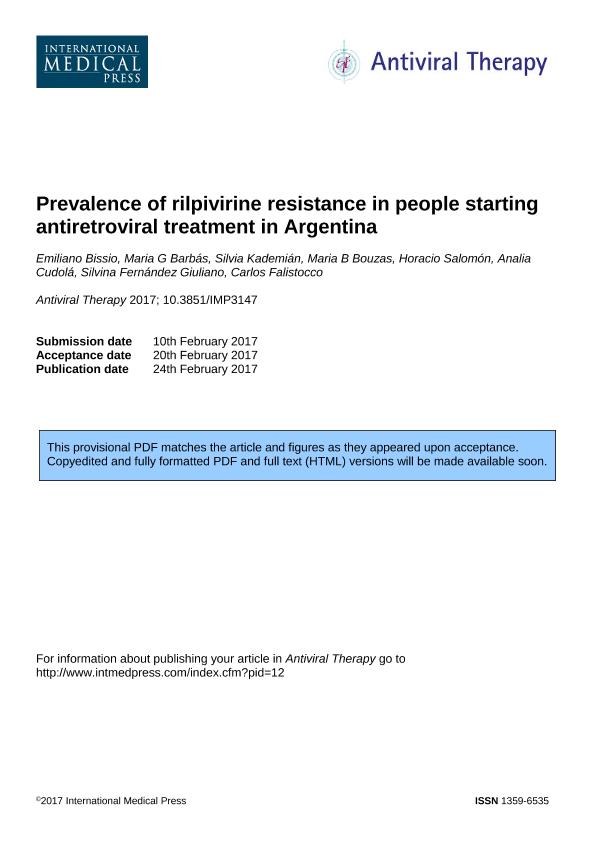Artículo
Prevalence of rilpivirine resistance in people starting antiretroviral treatment in Argentina
Bissio, Emiliano; Barbás, Maria G; Kademián, Silvia; Bouzas, Maria B; Salomon, Horacio Eduardo ; Cudola, Analia Ester; Fernández Giuliano, Silvina; Falistocco, Carlos
; Cudola, Analia Ester; Fernández Giuliano, Silvina; Falistocco, Carlos
 ; Cudola, Analia Ester; Fernández Giuliano, Silvina; Falistocco, Carlos
; Cudola, Analia Ester; Fernández Giuliano, Silvina; Falistocco, Carlos
Fecha de publicación:
02/2017
Editorial:
Int Medical Press Ltd
Revista:
Antiviral Therapy.
ISSN:
1359-6535
Idioma:
Inglés
Tipo de recurso:
Artículo publicado
Clasificación temática:
Resumen
Background: Rilpivirine-based regimens are now preferred or alternative first-line regimens according to many HIV treatment guidelines. Recently, a surveillance study conducted in Argentina determined that prevalence of pretreatment resistance to first-generation non-nucleoside reverse transcriptase inhibitors (NNRTIs) was 10%. The aim of this study was to analyse the prevalence of resistance mutations to newer generation NNRTIs in the population starting ART in Argentina. Methods: We analysed the prevalence of resistance mutations to rilpivirine and etravirine (according to the IAS list), obtained through a nationally representative pretreatment HIV-drug resistance (PDR) surveillance study performed in Argentina in 2014–2015. Briefly, 25 ART-dispensing sites throughout the country were randomly chosen to enrol 330 adults starting ART. Samples were processed with Trugene (Siemens)® and analysed using the Stanford algorithm. Results: All 270 samples corresponding to participants with no prior exposure to antiretroviral drugs were included in this analysis. Median (IQR) age was 35 years (28–43); 66.7% were male; median (IQR) CD4+ T-cell count was 284 cells/mm3 (112–489). The prevalence of resistance to any antiretroviral was 16% (±5%) and prevalence of NNRTI RAMs was 13% (±4%). The prevalence of resistance to rilpivirine was 8% (±3%). Prevalence of resistance to etravirine was 4% (±3%). The most frequent mutations conferring resistance to rilpivirine were: E138A (n=6) and G190A (n=4). Conclusions: This PDR surveillance study showed concerning levels of HIV drug resistance (HIVDR) in Argentina, not only for first-generation NNRTIs but also to rilpivirine. In our setting, performing resistance testing would be necessary before prescription of ART even if a second-generation NNRTI-based regimen was used as first-line therapy.
Palabras clave:
Hiv
,
Resistance
,
Prevalence
,
Rilpivirine
Archivos asociados
Licencia
Identificadores
Colecciones
Articulos(INBIRS)
Articulos de INSTITUTO DE INVESTIGACIONES BIOMEDICAS EN RETROVIRUS Y SIDA
Articulos de INSTITUTO DE INVESTIGACIONES BIOMEDICAS EN RETROVIRUS Y SIDA
Citación
Bissio, Emiliano; Barbás, Maria G; Kademián, Silvia; Bouzas, Maria B; Salomon, Horacio Eduardo; et al.; Prevalence of rilpivirine resistance in people starting antiretroviral treatment in Argentina; Int Medical Press Ltd; Antiviral Therapy.; 22; 7; 2-2017; 625-629
Compartir
Altmétricas



